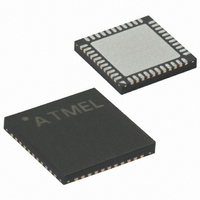ATMEGA8535-16MU Atmel, ATMEGA8535-16MU Datasheet - Page 201

ATMEGA8535-16MU
Manufacturer Part Number
ATMEGA8535-16MU
Description
IC AVR MCU 8K 16MHZ 5V 44-QFN
Manufacturer
Atmel
Series
AVR® ATmegar
Specifications of ATMEGA8535-16MU
Core Processor
AVR
Core Size
8-Bit
Speed
16MHz
Connectivity
I²C, SPI, UART/USART
Peripherals
Brown-out Detect/Reset, POR, PWM, WDT
Number Of I /o
32
Program Memory Size
8KB (4K x 16)
Program Memory Type
FLASH
Eeprom Size
512 x 8
Ram Size
512 x 8
Voltage - Supply (vcc/vdd)
4.5 V ~ 5.5 V
Data Converters
A/D 8x10b
Oscillator Type
Internal
Operating Temperature
-40°C ~ 85°C
Package / Case
44-VQFN Exposed Pad
Processor Series
ATMEGA8x
Core
AVR8
Data Bus Width
8 bit
Data Ram Size
512 B
Interface Type
2-Wire, SPI, USART
Maximum Clock Frequency
16 MHz
Number Of Programmable I/os
32
Number Of Timers
3
Operating Supply Voltage
4.5 V to 5.5 V
Maximum Operating Temperature
+ 85 C
Mounting Style
SMD/SMT
3rd Party Development Tools
EWAVR, EWAVR-BL
Development Tools By Supplier
ATAVRDRAGON, ATSTK500, ATSTK600, ATAVRISP2, ATAVRONEKIT
Minimum Operating Temperature
- 40 C
On-chip Adc
10 bit, 8 Channel
Package
44MLF EP
Device Core
AVR
Family Name
ATmega
Maximum Speed
16 MHz
For Use With
ATAVRISP2 - PROGRAMMER AVR IN SYSTEMATSTK500 - PROGRAMMER AVR STARTER KIT
Lead Free Status / RoHS Status
Lead free / RoHS Compliant
Available stocks
Company
Part Number
Manufacturer
Quantity
Price
Part Number:
ATMEGA8535-16MU
Manufacturer:
ATMEL/爱特梅尔
Quantity:
20 000
- Current page: 201 of 321
- Download datasheet (3Mb)
Combining Several TWI
Modes
Multi-master Systems
and Arbitration
2502K–AVR–10/06
In some cases, several TWI modes must be combined in order to complete the desired
action. Consider for example reading data from a serial EEPROM. Typically, such a
transfer involves the following steps:
1. The transfer must be initiated.
2. The EEPROM must be instructed what location should be read.
3. The reading must be performed.
4. The transfer must be finished.
Note that data is transmitted both from Master to Slave and vice versa. The Master must
instruct the Slave what location it wants to read, requiring the use of the MT mode. Sub-
sequently, data must be read from the Slave, implying the use of the MR mode. Thus,
the transfer direction must be changed. The Master must keep control of the bus during
all these steps, and the steps should be carried out as an atomical operation. If this prin-
ciple is violated in a multimaster system, another Master can alter the data pointer in the
EEPROM between steps 2 and 3, and the Master will read the wrong data location.
Such a change in transfer direction is accomplished by transmitting a REPEATED
START between the transmission of the address byte and reception of the data. After a
REPEATED START, the Master keeps ownership of the bus. The following figure shows
the flow in this transfer.
Figure 94. Combining Several TWI Modes to Access a Serial EEPROM
If Multiple Masters are connected to the same bus, transmissions may be initiated simul-
taneously by one or more of them. The TWI standard ensures that such situations are
handled in such a way that one of the masters will be allowed to proceed with the trans-
fer, and that no data will be lost in the process. An example of an arbitration situation is
depicted below, where two masters are trying to transmit data to a Slave Receiver.
Figure 95. An Arbitration Example
SDA
SCL
S
S = START
TRANSMITTER
Device 1
Transmitted from master to slave
SLA+W
MASTER
TRANSMITTER
A
Device 2
MASTER
Master Transmitter
ADDRESS
Device 3
RECEIVER
SLAVE
A
Rs = REPEATED START
Rs
Transmitted from slave to master
........
SLA+R
Device n
ATmega8535(L)
V
CC
A
Master Receiver
R1
DATA
R2
P = STOP
A
P
201
Related parts for ATMEGA8535-16MU
Image
Part Number
Description
Manufacturer
Datasheet
Request
R

Part Number:
Description:
IC AVR MCU 2.4GHZ XCEIVER 64QFN
Manufacturer:
Atmel
Datasheet:

Part Number:
Description:
Manufacturer:
Atmel
Datasheet:

Part Number:
Description:
MCU ATMEGA644/AT86RF230 40-DIP
Manufacturer:
Atmel
Datasheet:

Part Number:
Description:
BUNDLE ATMEGA644P/AT86RF230 QFN
Manufacturer:
Atmel
Datasheet:

Part Number:
Description:
BUNDLE ATMEGA644P/AT86RF230 TQFP
Manufacturer:
Atmel
Datasheet:

Part Number:
Description:
MCU ATMEGA1281/AT86RF230 64-TQFP
Manufacturer:
Atmel
Datasheet:

Part Number:
Description:
MCU ATMEGA1280/AT86RF230 100TQFP
Manufacturer:
Atmel
Datasheet:

Part Number:
Description:
BUNDLE ATMEGA1280/AT86RF100-TQFP
Manufacturer:
Atmel
Datasheet:

Part Number:
Description:
BUNDLE ATMEGA2560V/AT86RF230-ZU
Manufacturer:
Atmel
Datasheet:

Part Number:
Description:
MCU ATMEGA2561/AT86RF230 64-TQFP
Manufacturer:
Atmel
Datasheet:

Part Number:
Description:
INTERVAL AND WIPE/WASH WIPER CONTROL IC WITH DELAY
Manufacturer:
ATMEL Corporation
Datasheet:

Part Number:
Description:
Low-Voltage Voice-Switched IC for Hands-Free Operation
Manufacturer:
ATMEL Corporation
Datasheet:

Part Number:
Description:
MONOLITHIC INTEGRATED FEATUREPHONE CIRCUIT
Manufacturer:
ATMEL Corporation
Datasheet:

Part Number:
Description:
AM-FM Receiver IC U4255BM-M
Manufacturer:
ATMEL Corporation
Datasheet:











